A Numerical Study on the Effects of Trust in Supplier Development
Abstract
1. Introduction
1.1. Supplier Development
- Non-Cooperative:
- In this scheme, OEMs do not interact with each other, in terms of neither active resource nor information sharing. This scheme assumes that each OEM renders its own decision regarding the supplier development program, optimizing its investments and profits. Despite this focus, each OEM also benefits from the other one’s investments as the supplier increases in efficiency.
- Sequential:
- This scheme represents an asymmetrical form of collaboration between two involved OEMs. As in the non-cooperative case, both manufacturers render their own decisions. In contrast, one of the manufacturers provides its plans to the other one. As a result, the scheme shows a unidirectional information flow. When relating to the topic of trust, such a situation can occur in early stages where one OEM begins conveying information to another to start building trust and show goodwill slowly.
- Simultaneous:
- This scheme represents a more advanced form of collaboration where both involved OEMs negotiate their activities. Thereby, each OEM renders a decision concerning its investments and profit, and both convey their plans to the other. Using shared information, both parties then optimize their plans and update the other partner.
- Full-Cooperative:
- This scheme assumes that OEMs not only share all relevant information but also try to find the “best solution” for both partners using a shared pool of resources and fully sharing the benefits. Such situations might occur in joint ventures or companies closely tied together by corporate groups. Examples for such groups are the Volkswagen Group (Audi, Volkswagen, Porsche, etc.) or General Motors (Cadillac, Chevrolet, etc.). This scheme diverges from the first three, as it implies that OEMs conduct a single optimization that optimizes across both partners.
1.2. Trust in Supply Chain Collaboration
1.2.1. Classification of Factors Influencing Trust
1.2.2. Quantification of Trust
1.3. Notation
2. Materials and Methods
2.1. Step 1: Trust Factors and System State
- Reputation (static)
- This parameter, denoted as , describes the perceived reputation of an OEM’s partner. Therefore, it subsumes the determinants Ability, Capability, Reputation, Emotions, and Cognition from Trustor, as given in Table 1.
- History (static)
- This parameter, denoted as , provides a value to rate the general quality of historic transactions one OEMm had with the other partner. This parameter particularly includes past collaborations in supplier development, as well as other interactions between these partners.
- Specificity (static)
- This parameter, denoted as , summarizes the determinants Asset Specificity, Satisfaction with Know-How, and Satisfaction with Specialities. Consequently, it provides a requirement to establish trust in cooperation between competing companies. If, e.g., both OEMs target vastly different market segments (high specificity), both partners will engage in cooperative transactions easier than actively competing companies.
- Commitment (static)
- This parameter, denoted as , summarizes the determinants Commitment, Incentive Alignment, and Bargaining Power, given in Table 1, and, therefore, denotes how strongly an OEMm rates the commitment of its partner in a joint supplier development program.
- Recent Experience (dynamic)
- This dynamic parameter, denoted as , summarizes the determinants Benevolence, Joint Knowledge Creation, and Experiences. It represents the quality of the current joint supplier development program as OEMm perceives it. This parameter’s value strongly depends on the current revenue and benefits generated by the program.
- Information Sharing (dynamic)
- This dynamic parameter, denoted as , summarizes the determinants Information Sharing, Communication, and Openness. Consequently, it highly depends on the current willingness to share information between partners.
- Information Mismatch (dynamic)
- This dynamic parameter, denoted as , summarizes the determinants Honesty, Positive Mutual Understanding, and Information Mismatch. In this article, we interpret this parameter as an indicator of the matching of expectations between OEMs. For example, if OEM1 expects to receive information on OEM2’s supplier development program, but does not receive it, the mismatch would increase.
- Opportunism (dynamic)
- This dynamic parameter, denoted as , describes how opportunistic an OEM classifies its partner’s actions. Previous studies showed that some collaboration schemes facilitate opportunistic behavior, where one OEM would not invest in the joint supplier until the other one ceases investments.
2.2. Step 2: Quantification of Trust
2.3. Step 3: Selection and Parameterization of Collaboration Schemes
2.4. Step 4: Open-Loop Optimization
2.5. Step 5: Control Extraction and Application
- Experience:
- This factor directly relates to the advantages that the OEM gains from collaborating with its partner. Thus, as a general rule of thumb, this factor should increase depending on how much the other partner invests. In contrast, the value should decrease if one OEM invests, but its partner does not.
- Information Mismatch:
- This factor depends on the correctness of information obtained by each OEMs’ partner. With the current collaboration schemes, only the simultaneous scheme shows the potential for conveying changing information, as all other schemes assume that the provided information is fixed. The simultaneous scheme thereby assumes a negotiation where each OEM revises its decision using its partner’s current information. To represent the effects of such non-fixed information, we propose to penalize lengthy negotiations, while short negotiations (or the conveyance of fixed information) should be rewarded.
- Information Sharing:
- This factor rates the partners’ tendency to share information in general. We propose to implement a rule set that directly ranks the selected collaboration scheme to this factor. Consequently, we can formulate a mapping, which, e.g., assigns a high value to this factor if both partners are collaborating fully and a low value if no collaboration exists.
- Opportunism:
- Similar to the factor experience, this factor assesses the other partner’s behavior in terms of its investment strategy. We propose to evaluate a defined number of past time instances for opportunistic behavior. Thereby, we interpret opportunistic behavior as an OEM just relying on the investment of its partner to gain benefits from the supplier development, while not investing on its own.
3. Results
3.1. Scenario Description
3.2. Evaluation of the Optimization Focus
3.3. Comparison of Investment Strategies with and without Regarding Trust
3.4. Dynamic Adaptation of the Optimization Focus
4. Conclusions
Author Contributions
Funding
Conflicts of Interest
References
- Dastyar, H.; Pannek, J. Numeric Evaluation of Game-Theoretic Collaboration Modes in Supplier Development. Appl. Sci. 2019, 9, 4331. [Google Scholar] [CrossRef]
- Dastyar, H.; Rippel, D.; Freitag, M. Optimization of Supplier Development under Market Dynamics. Math. Probl. Eng. 2020. In Print. [Google Scholar] [CrossRef]
- Daudi, M. Trust in Sharing Resources in Logistics Collaboration. Ph.D. Thesis, Universität Bremen, Bremen, Germany, 2018. [Google Scholar]
- Chow, S.; Holden, R. Toward an understanding of loyalty: The moderating role of trust. J. Manag. Issues 1997, 9, 275–298. [Google Scholar]
- Möllering, G. Perceived trustworthiness and inter-firm governance: Empirical evidence from the UK printing industry. Camb. J. Econ. 2002, 26, 139–160. [Google Scholar] [CrossRef]
- Bolton, G.E.; Katok, E.; Ockenfels, A. How Effective Are Electronic Reputation Mechanisms? An Experimental Investigation. Manag. Sci. 2004, 50, 1587–1602. [Google Scholar] [CrossRef]
- Smith, J.B.; Barclay, D.W. The effects of organizational differences and trust on the effectiveness of selling partner relationships. J. Mark. 1997, 61, 3–21. [Google Scholar] [CrossRef]
- Doney, P.; Cannon, J. An examination of the nature of trust in buyer-seller relationship. J. Mark. 1997, 61, 35–51. [Google Scholar]
- Plank, R.E.; Reid, D.A.; Pullins, E.B. Perceived trust in business-to-business sales: A new measure. J. Pers. Sell. Sales Manag. 1999, 19, 61–71. [Google Scholar]
- Gassenheimer, J.B.; Manolis, C. The influence of product customization and supplier selection on future intentions: The mediating effects of salesperson and organizational trust. J. Manag. Issues 2001, 3, 418–435. [Google Scholar]
- Han, G.; Dong, M. Trust-embedded coordination in supply chain information sharing. Int. J. Prod. Res. 2015, 53, 5624–5639. [Google Scholar] [CrossRef]
- Talluri, S.; Narasimhan, R.; Chung, W. Manufacturer cooperation in supplier development under risk. Eur. J. Oper. Res. 2010, 207, 165–173. [Google Scholar] [CrossRef]
- Govindan, K.; Kannan, D.; Haq, A.N. Analyzing supplier development criteria for an automobile industry. Ind. Manag. Data Syst. 2010, 110, 43–62. [Google Scholar] [CrossRef]
- Bai, C.; Sarkis, J. Green supplier development: Analytical evaluation using rough set theory. J. Clean. Prod. 2010, 18, 1200–1210. [Google Scholar] [CrossRef]
- Wagner, S. A firm’s responses to dficient suppliers and competitive advantage. J. Bus. Res. 2006, 59, 686–695. [Google Scholar] [CrossRef]
- Krause, D.R. The antecedents of buying firms’ efforts to improve suppliers. J. Oper. Manag. 1999, 17, 205–224. [Google Scholar] [CrossRef]
- Li, H.; Wang, Y.; Yin, R.; Kull, T.J.; Choi, T.Y. Target pricing: Demand-side versus supply-side approaches. Int. J. Prod. Econ. 2012, 136, 172–184. [Google Scholar] [CrossRef]
- Wagner, S. Supplier development and the relationship life-cycle. Int. J. Prod. Econ. 2011, 129, 277–283. [Google Scholar] [CrossRef]
- Sánchez-Rodríguez, C.; Hemsworth, D.; Martínez-Lorente, A.R. The effect of supplier development initiatives on purchasing performance: A structural model. Supply Chain Manag. Int. J. 2005, 10, 289–301. [Google Scholar] [CrossRef]
- Krause, D.R.; Handfield, R.B.; Tyler, B.B. The relationships between supplier development, commitment, social capital accumulation and performance improvement. J. Oper. Manag. 2006, 25, 528–545. [Google Scholar] [CrossRef]
- Bai, C.; Sarkis, J. Supplier development investment strategies: A game theoretic evaluation. Ann. Oper. Res. 2014, 240, 583–615. [Google Scholar] [CrossRef]
- Parsons, S.; Wooldridge, M. Game Theory and Decision Theoryin Multi-Agent Systems. Auton. Agents Multi-Agent Syst. 2002, 5, 243–254. [Google Scholar] [CrossRef]
- Spekman, R.E.; Davis, E.W. The Extended Enterprise: Gaining Competitive Advantage Through Collaborative Supply Chains; Prentice Hall PTR: Upper Saddle River, NJ, USA, 2003. [Google Scholar]
- Chopra, S.; Meindl, P. Supply Chain Management: Strategy, Planning, and Operation (4th Global); Prentice Hall PTR: Upper Saddle River, NJ, USA; Pearson: Upper Saddle River, NJ, USA, 2010. [Google Scholar]
- Cummings, L.; Bromiley, P. The Organizational Trust Inventory (OTI): Development and Validation. In Trust in Organizations: Frontiers of Theory and Research; Kramer, R., Tyler, T., Eds.; SAGE Publications, Inc.: Thousand Oaks, CA, USA, 1996; pp. 302–330. [Google Scholar] [CrossRef]
- Schoorman, F.D.; Mayer, R.C.; Davis, J.H. An Integtative Model of Organizational Trust: Past, Present, and Future. Acad. Manag. Rev. 2007, 32, 344–354. [Google Scholar] [CrossRef]
- Msanjila, S.S.; Afsarmanesh, H. Trust analysis and assessment in virtual organization breeding environments. Int. J. Prod. Res. 2008, 46, 1253–1295. [Google Scholar] [CrossRef]
- Ha, B.; Park, Y.; Cho, S. Suppliers’ affective trust and trust in competency in buyers. Int. J. Oper. Prod. Manag. 2011, 31, 56–77. [Google Scholar] [CrossRef]
- McAllister, D.J. Affect- and Cognition-based Trust as Foundations for Interpersonal Cooperation in Organizations. Acad. Manag. J. 1995, 38, 24–59. [Google Scholar]
- Tzafrir, S.; Dolan, S.L. Trust Me: A Scale for Measuring Manager-Employee Trust. Manag. Res. J. Iberoam. Acad. Manag. 2004, 2, 115–132. [Google Scholar] [CrossRef]
- Morgan, R.M.; Hunt, S.D. The Commitment-Trust Theory of Relationship Marketing. J. Mark. 1994, 58, 20. [Google Scholar] [CrossRef]
- Smith, G. How to achieve organizational trust within an accounting department. Manag. Audit. J. 2005, 20, 520–523. [Google Scholar] [CrossRef]
- Moberg, C.R.; Speh, T.W. Evaluating the Relationship between Queationable Practices and the Strength of Supply Chain Relationships. J. Bus. Logist. 2003, 24, 1–19. [Google Scholar] [CrossRef]
- Rinehart, L.M.; Eckert, J.A.; Handfield, R.B.; Page, T.J. An assessment of supplier-customer relationships. J. Bus. Logist. 2004, 25, 25–62. [Google Scholar] [CrossRef]
- Park, M.; Park, S.; Mele, F. Modeling of Purchase and Sales Contracts in Supply Chain Optimization. Ind. Eng. Chem. Res. 2006, 45, 5013–5026. [Google Scholar] [CrossRef][Green Version]
- Laeequddin, M.; Sahay, B.S.; Sahay, V.; Waheed, K.A. Measuring trust in supply chain partners’ relationships. Meas. Bus. Excell. 2010, 14, 53–69. [Google Scholar] [CrossRef]
- Skandrani, H.; Triki, A.; Baratli, B. Trust in supply chains, meanings, determinants and demonstrations. Qual. Mark. Res. Int. J. 2011, 14, 391–409. [Google Scholar] [CrossRef]
- Tejpal, G.; Garg, R.K.; Sachdeva, A. Trust among supply chain partners: A review. Meas. Bus. Excell. 2013, 17, 51–71. [Google Scholar] [CrossRef]
- Hudnurkar, M.; Jakhar, S.; Rathod, U. Factors Affecting Collaboration in Supply Chain: A Literature Review. Procedia-Soc. Behav. Sci. 2014, 133, 189–202. [Google Scholar] [CrossRef]
- Ouzrout, Y.; Chaze, L.; Lavastre, O.; Dominguez, C.; Akhter, S.H. Simulation of Trust in Supply Chains. In Supply Chain Performance; John Wiley & Sons, Inc.: Hoboken, NJ, USA, 2013; pp. 267–315. [Google Scholar] [CrossRef]
- Wang, X.; Kopfer, H. Increasing Efficiency of Freight Carriers through Collaborative Transport Planning: Chances and Challenges. In Dynamics and Sustainability in International Logistics and Supply Chain Management; Ivanov, D., Kopfer, H., Haasis, H.D., Schönberger, J., Eds.; Cuvillier: Gottingen, Germany, 2011; pp. 41–50. [Google Scholar]
- Jeng, D.J.; Mortel, C.H.A. Impact of trust, asset specificity, and environmental uncertainty on manufacturing collaborative processes. In Proceedings of the 40th International Conference on Computers Indutrial Engineering, Awaji, Japan, 25–28 July 2010; pp. 1–7. [Google Scholar] [CrossRef]
- Kwon, I.G.; Suh, T. Trust, commitment and relationships in supply chain management: A path analysis. Supply Chain Manag. Int. J. 2005, 10, 26–33. [Google Scholar] [CrossRef]
- Jones, S.L.; Fawcett, S.E.; Wallin, C.; Fawcett, A.M.; Brewer, B.L. Can small firms gain relational advantage? Exploring strategic choice and trustworthiness signals in supply chain relationships. Int. J. Prod. Res. 2014, 52, 5451–5466. [Google Scholar] [CrossRef]
- Wu, I.L.; Chuang, C.H.; Hsu, C.H. Information sharing and collaborative behaviors in enabling supply chain performance: A social exchange perspective. Int. J. Prod. Econ. 2014, 148, 122–132. [Google Scholar] [CrossRef]
- Cao, M.; Zhang, Q. Supply chain collaboration: Impact on collaborative advantage and firm performance. J. Oper. Manag. 2010, 29, 163–180. [Google Scholar] [CrossRef]
- Cruijssen, F. Horizontal Cooperation in Transport and Logistics. Ph.D. Thesis, Universiteit van Tilburg, Warandelaan, The Netherlands, 2006. [Google Scholar]
- Xu, X. Collaboration Mechanism in Horizontal Logistics Collaboration. Ph.D. Thesis, L’École Nationale Supérieure des Mines de Paris, Paris, France, 2013. [Google Scholar]
- Chen, J.V.; Yen, D.C.; Rajkumar, T.M.; Tomochko, T.M. The antecedent factors on trust and commitment in supply chain relationships. Comput. Stand. Interfaces 2011, 33, 262–270. [Google Scholar] [CrossRef]
- Yin, M.; Zhao, S. Information sharing as antecedent of dynamic trust and cooperation intention in supply chain: Evidence from China. In Proceedings of the 2008 International Conference on Management Science and Engineering 15th Annual Conference Proceedings, Long Beach, CA, USA, 10–12 September 2008; pp. 298–305. [Google Scholar] [CrossRef]
- Su, Q.; Song, Y.; Li, Z.; Dang, J. The impact of supply chain relationship quality on cooperative strategy. J. Purch. Supply Manag. 2008, 14, 263–272. [Google Scholar] [CrossRef]
- Min, S.; Mentzer, J.T. Developing and measuring supply chain management concepts. J. Bus. Logist. 2004, 25, 63–99. [Google Scholar] [CrossRef]
- Child, J. Trust—The fundamental bond in global collaboration. Organ. Dyn. 2001, 29, 274–288. [Google Scholar] [CrossRef]
- Lewicki, R.L.; Bunker, B.B. Developing and Maintaining Trust in Work Relationships. In Trust in Organizations: Frontiers of Theory and Research; Kramer, R., Tyler, T., Eds.; SAGE Publications, Inc.: Thousand Oaks, CA, USA, 1996; pp. 114–139. [Google Scholar] [CrossRef]
- Whitener, E.M.; Brodt, S.E.; Korsgaard, M.A.; Werner, J.M. Managers as Initiators of Trust: An Exchange Relationship Framework for Understanding Managerial Trustworthy Behavior. Acad. Manag. Rev. 1998, 23, 513. [Google Scholar] [CrossRef]
- Rousseau, D.M.; Sitkin, S.B.; Burt, R.S.; Camerer, C.F. Not So Different After All: A Cross-discipline View of Trust. Acad. Manag. Rev. 1998, 23, 393–404. [Google Scholar] [CrossRef]
- Daudi, M.; Hauge, J.B.; Thoben, K.D. Behavioral factors influencing partner trust in logistics collaboration: A review. Logist. Res. 2016, 9, 19. [Google Scholar] [CrossRef]
- Mayer, R.C.; Davis, J.H.; Schoorman, F.D. An integrative model of organizational trust. Acad. Manag. Rev. 1995, 32, 709–734. [Google Scholar] [CrossRef]
- Comer, J.M.; Plank, R.E.; Reid, D.A.; Pullins, E. Methods in Sales Research: Perceived Trust in Business-to-Business Sales: A New Measure. J. Pers. Sell. Sales Manag. 2013, 19, 61–71. [Google Scholar]
- De Silva, C.W. Intelligent Control - Fuzzy Logic Applications; CRC Press: Boca Raton, FL, USA, 2018. [Google Scholar]
- Proch, M.; Worthmann, K.; Schlüchtermann, J. A negotiation-based algorithm to coordinate supplier development in decentralized supply chains. Eur. J. Oper. Res. 2017, 256, 412–429. [Google Scholar] [CrossRef]
- Statistisches Bundesamt Deutschland. DE STATIS. GENESIS-Online Datenbank. Available online: https://www-genesis.destatis.de/genesis/online (accessed on 5 March 2020).
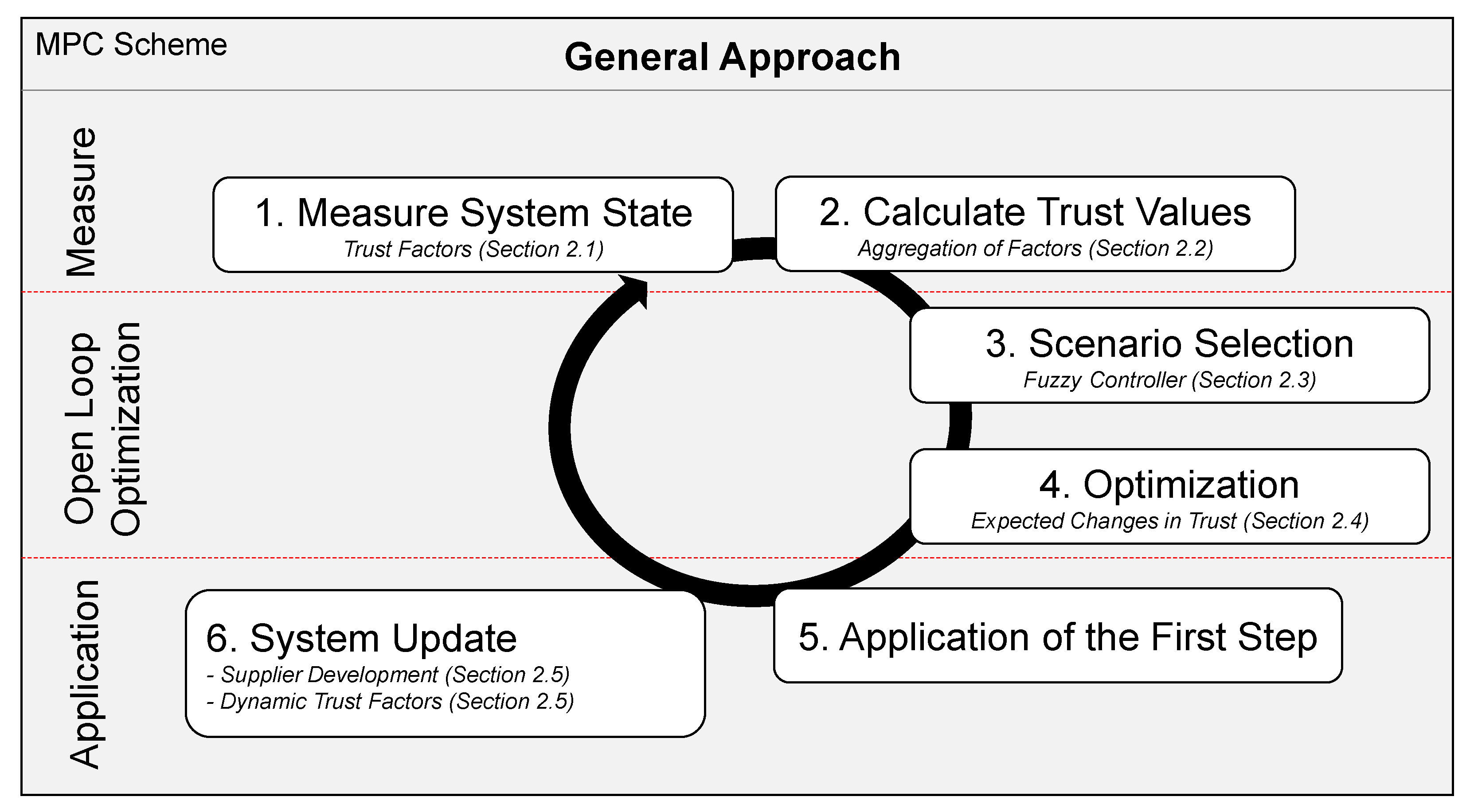

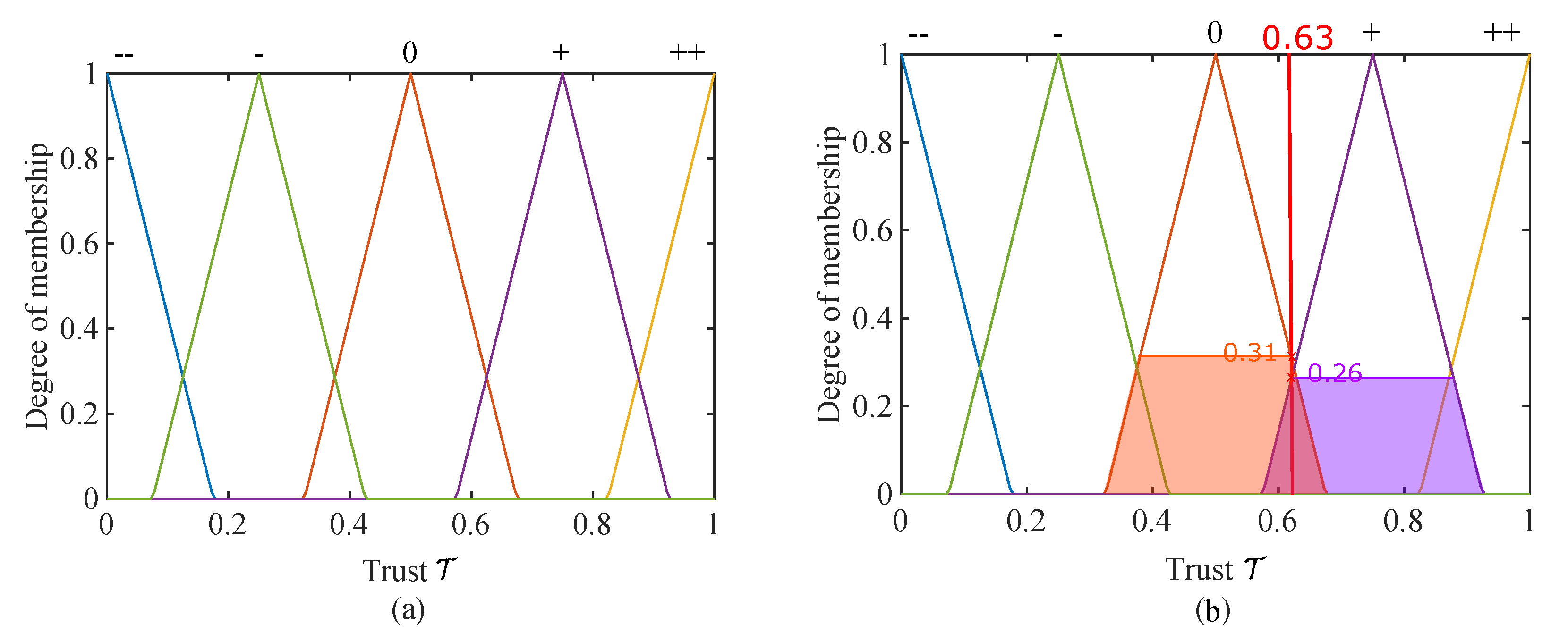
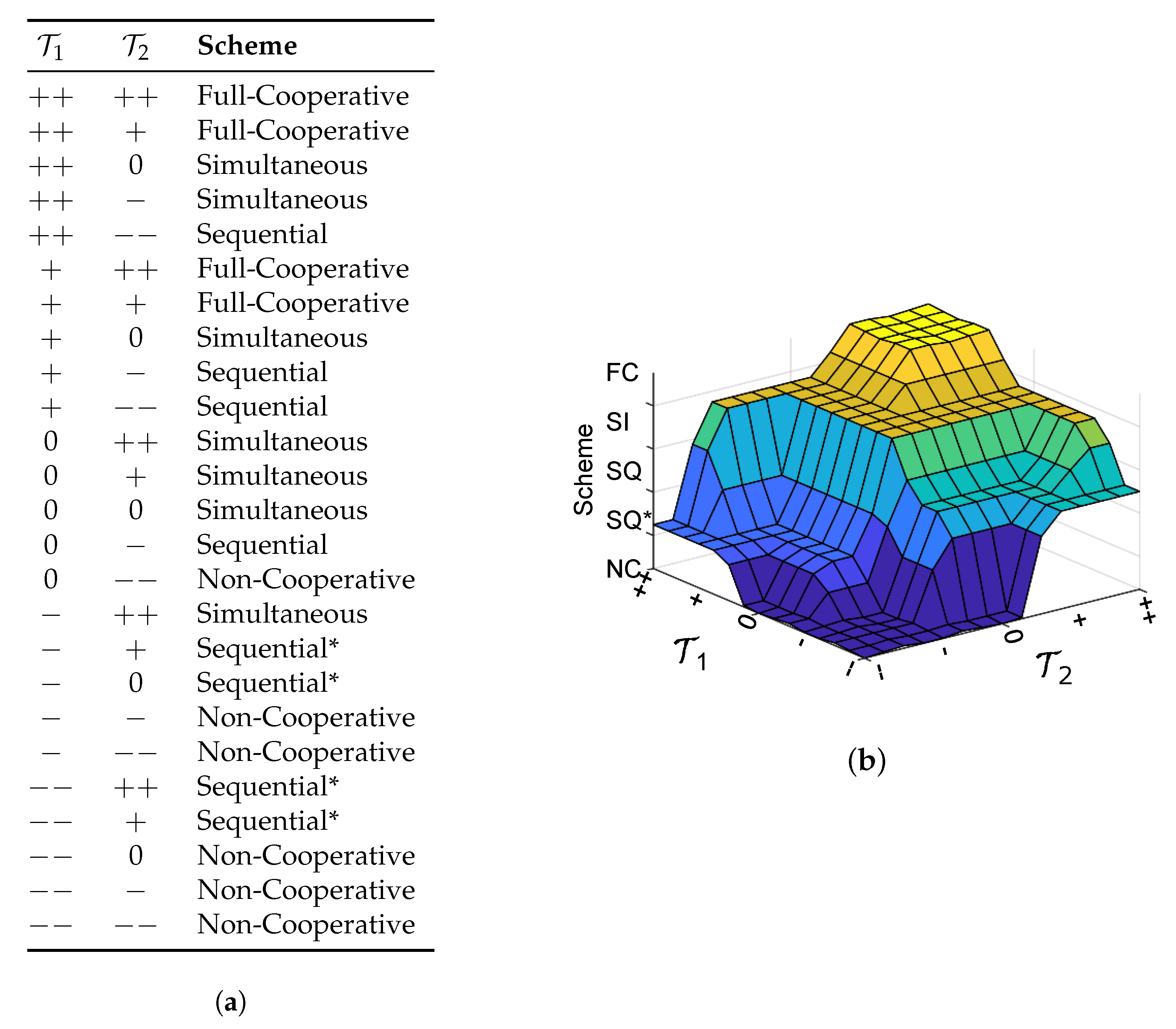
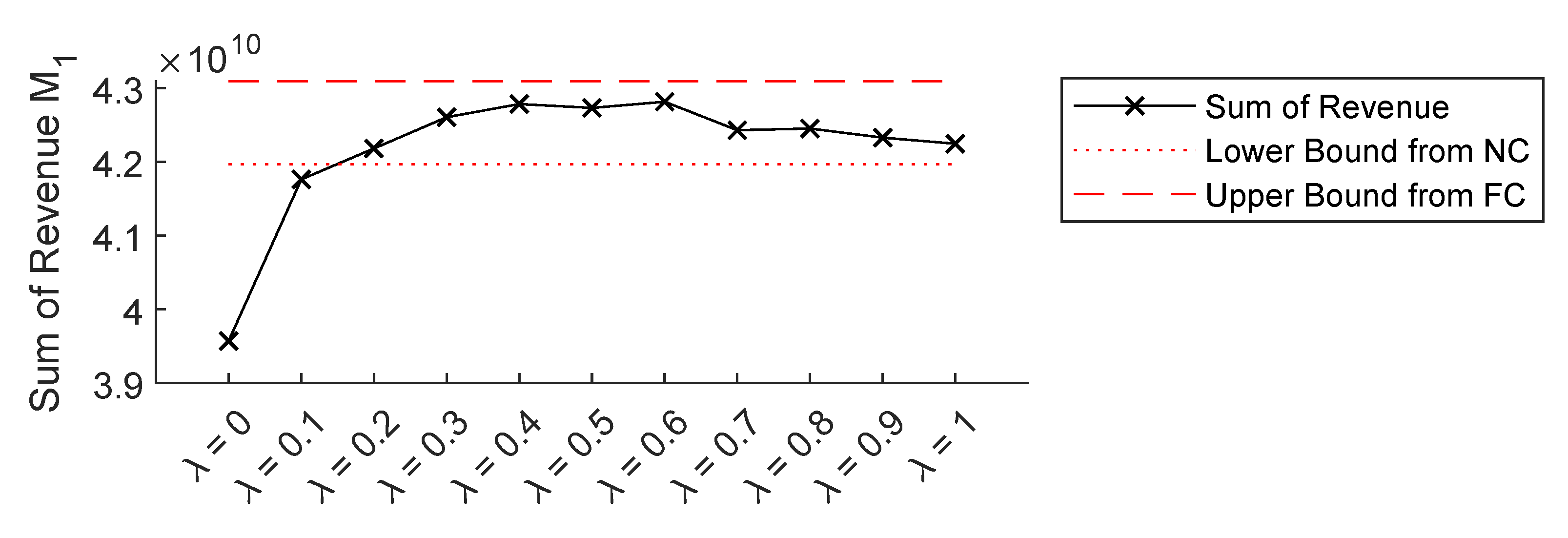
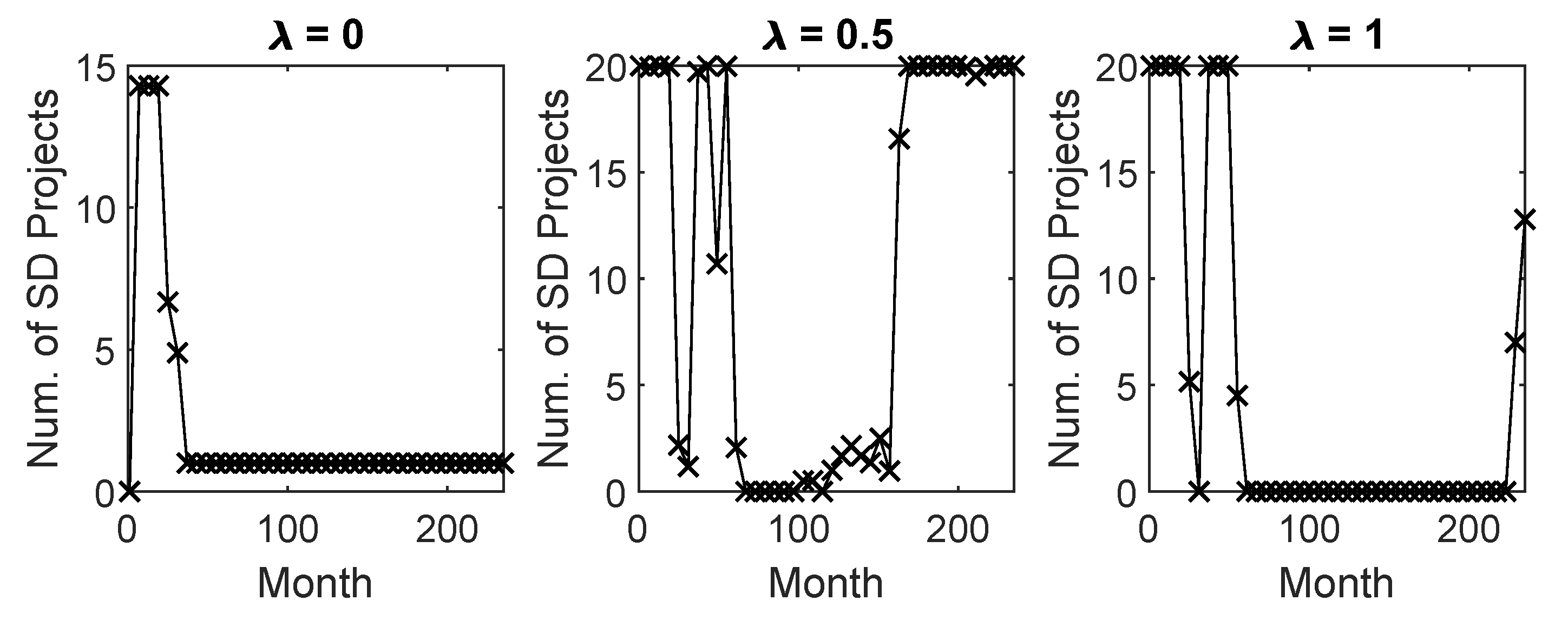
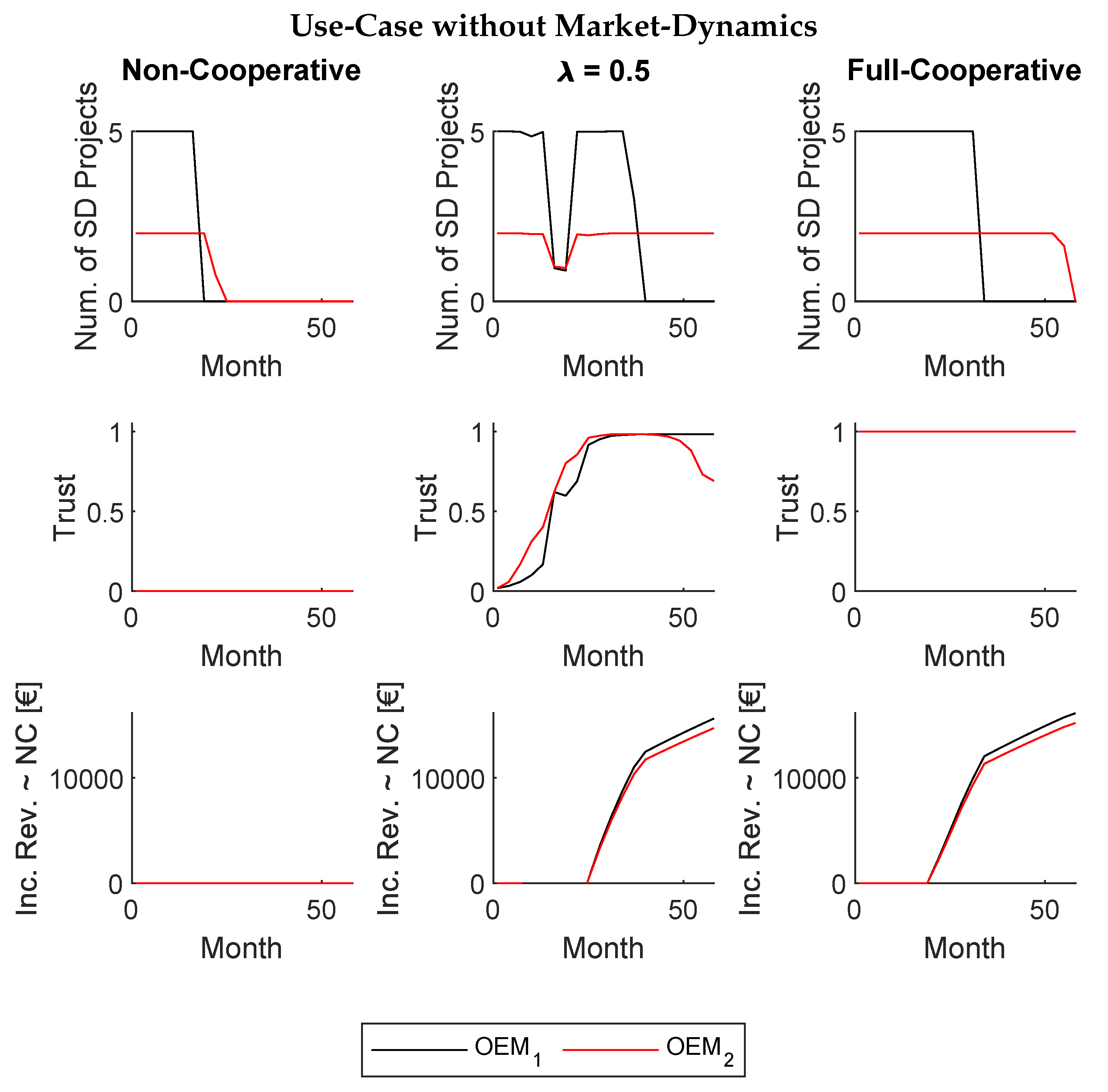
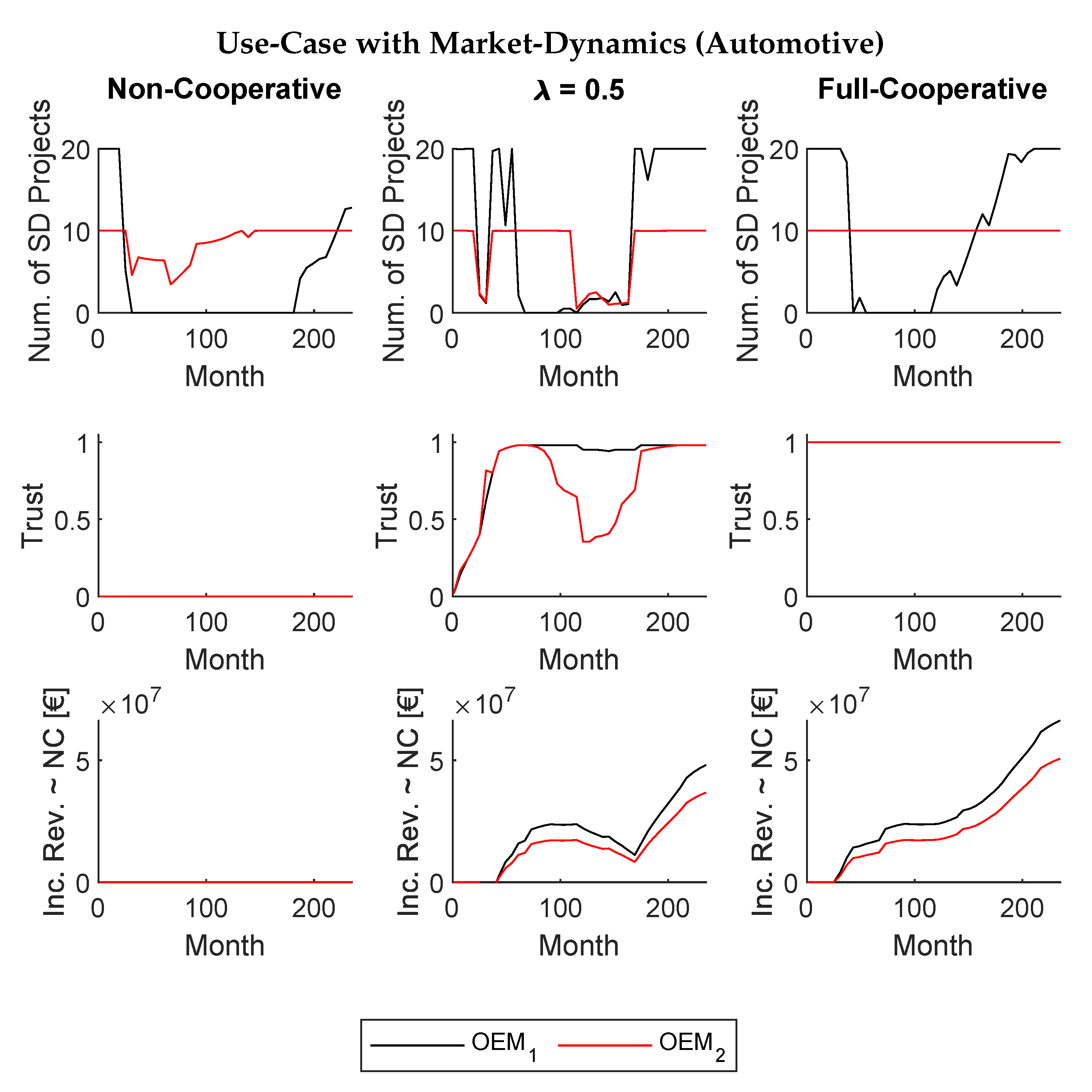
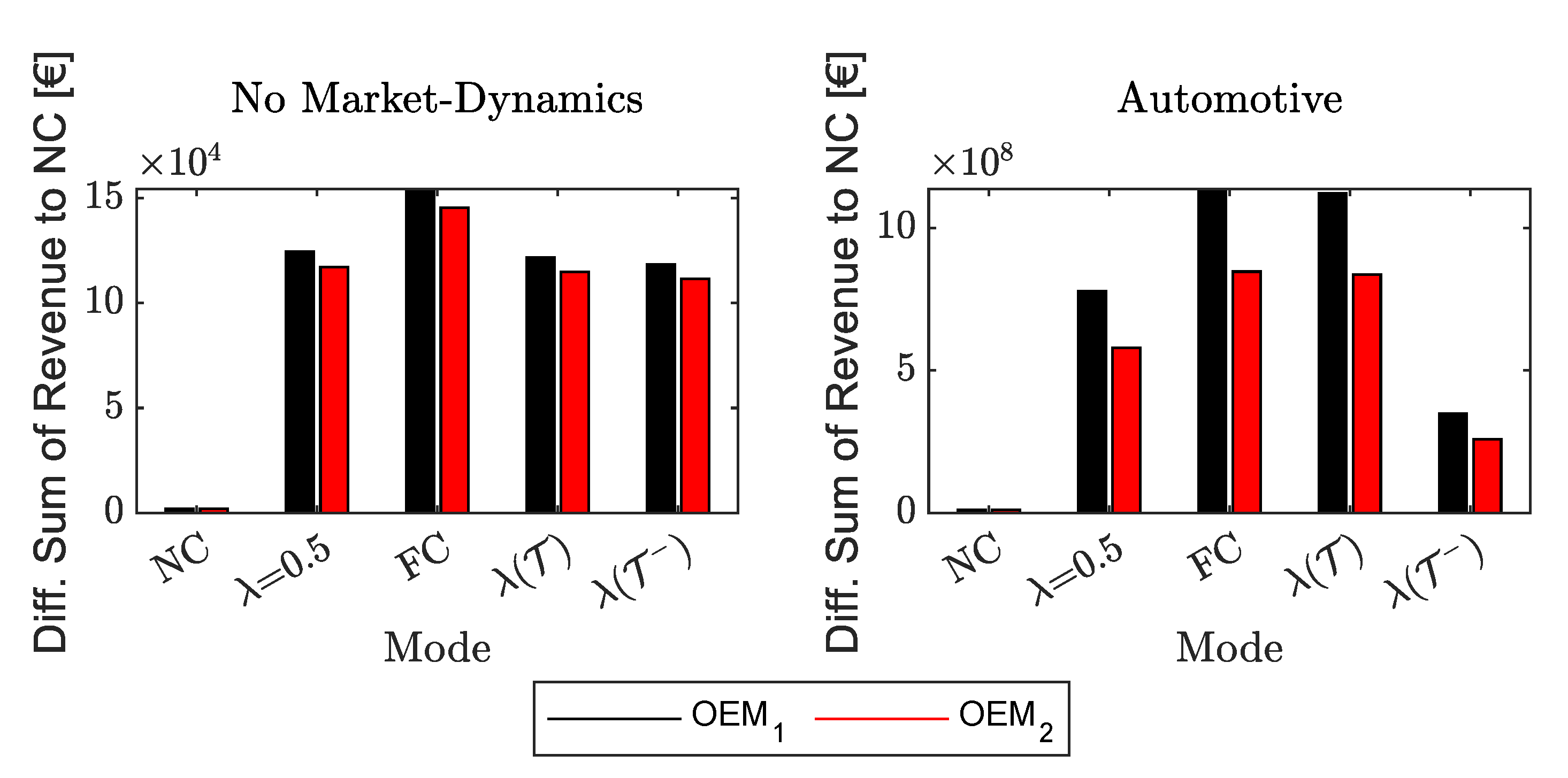
| Trust Factors | |
|---|---|
| Dynamic Factors | Static Factors |
| Benevolence [6,25,26,27,28] | Ability [28,29,30] |
| Honesty [8,28,31,32,33,34,35] | Capability [3,36,37,38] |
| Opportunism [3,38,39,40,41] | Asset specificity [3,42,43] |
| Commitment [3,36,37,40,44,45] | Incentive alignment [3,41,46,47,48] |
| Information sharing [3,37,43,45,49,50] | Bargaining power [43,44,47,48] |
| Communication [3,46,51] | Satisfaction with know-how/specialties [8,34,35] |
| Joint knowledge creation [3,46] | Unique knowledge/skills in business [8,33,35,52,53] |
| Openness [8,33,34,35] | Reputation [35] |
| Positive mutual understanding [8,33,35,54] | Historical transaction [35] |
| Respect [8,35,52,55] | Emotions [35] |
| Information mismatch [37,43,45,49,50] | Experiences [35] |
| Cognition from trustor [35] | |
| Indices with | |
| i | Index used for time instances |
| n | Index used for sampling instances |
| m | Index of OEM |
| Parameter sets used in the optimization (please refer to Table 3 for an in-depth description) | |
| Contains parameters relating to the supplier development | |
| R | Contains static trust factors |
| Contains dynamic trust factors | |
| Contains parameters used by the open-loop’s prediction modes to estimate trust and its effects | |
| General parameters | |
| T | Sampling step size for the MPC algorithm given in months with |
| P | Number of periods regarded in the MPC’s open-loop optimization with |
| N | Prediction horizon of the MPC’s open-loop optimization given as |
| State Vector | |
| Trust that OEMm places in its partner. with | |
| Parameters used for state updates (all in ) | |
| Increase or decrease of the factor experience during the closed-loop state update | |
| Increase or decrease of the factor opportunism during the closed-loop state update | |
| Increase or decrease of the factor information mismatch during the closed-loop state update | |
| Increase or decrease of the trust level during the open-loop state update due to experience | |
| Increase or decrease of the trust level during the open-loop state update due to opportunism | |
| Increase or decrease of the trust level during the open-loop state update due to information mismatch | |
| Parameters used in the cost function | |
| Customer’s willingness-to-pay for the product of OEMm with | |
| Cost for supplier development projects of OEMm with | |
| OEMm’s production cost with | |
| Supplier’s production cost related to the product of OEMm with | |
| Price elasticity chosen by OEMm with | |
| r | Supplier’s revenue for OEMm’s product with |
| l | Supplier’s learning rate with |
| Decision variables | |
| Optimal control sequence of length P obtained by the open-loop simulation for OEMm | |
| Variable | Subset | Description |
|---|---|---|
| Sum of supply development projects conducted by OEM with index m | ||
| R | Reputation of the other OEM as perceived by OEM with index m | |
| R | Transaction history of the other OEM as perceived by OEM with index m | |
| R | Asset specificity of the other OEM as perceived by OEM with index m | |
| R | Commitment of the other OEM as perceived by OEM with index m | |
| Short-term experience with the other OEM as perceived by OEM m | ||
| Information mismatch with the other OEM as perceived by OEM m | ||
| Tendency to share information by the other OEM as perceived by OEM m | ||
| Opportunism of the other OEM as perceived by OEM m | ||
| Expected trust scenario for OEMs used in the open-loop’s prediction models | ||
| Expected minimal revenue obtained by not collaborating for OEMs used in the open-loop’s prediction models | ||
| Expected maximum revenue obtained by fully collaborating for OEMs used in the open-loop’s prediction models | ||
| Weighting factor between maximizing revenue or trust in the open-loop’s prediction models |
| No Market Dynamics | Automotive | |||
|---|---|---|---|---|
| Parameter | OEM1 | OEM2 | OEM1 | OEM2 |
| Sampling Step Size | 3 month | 6 month | ||
| Prediction Horizon | 15*3 = 45 month | 9*6 = 54 month | ||
| Program Duration | 20*3 = 60 month | 40*6 = 240 month | ||
| a | 200 | 200 | 10,000 | 10,000 |
| 7500 | 6500 | 3,000,000 | 2,000,000 | |
| b | 0.01 | 0.01 | 0.01 | 0.01 |
| 65 | 70 | 4500 | 5400 | |
| 100 | 110 | 4050 | 3240 | |
| r | 10 | 15 | 450 | 360 |
| l | −0.1 | −0.1 | −0.1 | −0.1 |
| 5 | 2 | 20 | 10 | |
© 2020 by the authors. Licensee MDPI, Basel, Switzerland. This article is an open access article distributed under the terms and conditions of the Creative Commons Attribution (CC BY) license (http://creativecommons.org/licenses/by/4.0/).
Share and Cite
Dastyar, H.; Rippel, D.; Pannek, J.; Thoben, K.-D.; Freitag, M. A Numerical Study on the Effects of Trust in Supplier Development. Processes 2020, 8, 300. https://doi.org/10.3390/pr8030300
Dastyar H, Rippel D, Pannek J, Thoben K-D, Freitag M. A Numerical Study on the Effects of Trust in Supplier Development. Processes. 2020; 8(3):300. https://doi.org/10.3390/pr8030300
Chicago/Turabian StyleDastyar, Haniyeh, Daniel Rippel, Jürgen Pannek, Klaus-Dieter Thoben, and Michael Freitag. 2020. "A Numerical Study on the Effects of Trust in Supplier Development" Processes 8, no. 3: 300. https://doi.org/10.3390/pr8030300
APA StyleDastyar, H., Rippel, D., Pannek, J., Thoben, K.-D., & Freitag, M. (2020). A Numerical Study on the Effects of Trust in Supplier Development. Processes, 8(3), 300. https://doi.org/10.3390/pr8030300





